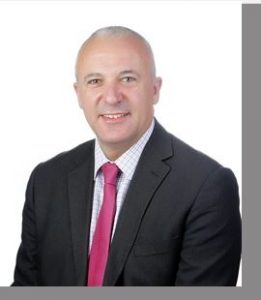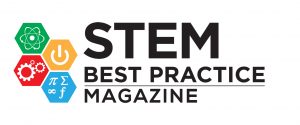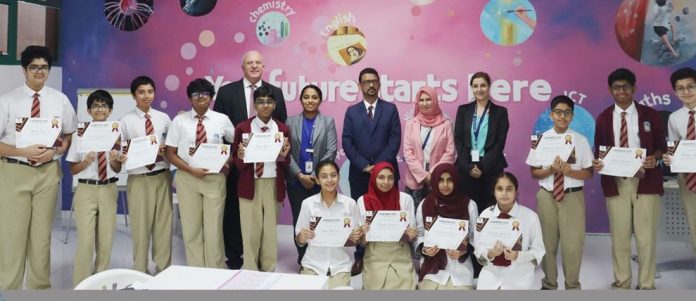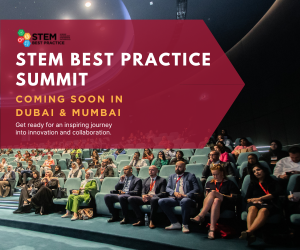By Dr. Tim Hughes
BSc., PhD., CSci., CChem FRSC., CPhys MInstP, PGCE, NPQH
The evolution of acronyms
Before 2001, students would likely be attending Science, Design Technology, and Maths lessons (where depending on the student’s age Science was presented as one subject, split into Physical Sciences and Biology, or as separate Chemistry, Physics, and Biology topics), with Engineering possibly being on the curriculum and / or being used to provide a context / real-world cross-curricular links to the learning. It could be said that it was the ‘S’ and ‘M’ that dominated, notwithstanding that they were compulsory for students to study, and that the ‘T’ and ‘E’ were less predominant. Is that still the case?
TIMSS and PISA outcomes at the time identified concerns regarding scientific knowledge, competency, and understanding, so the STEM acronym was created by the US National Science Foundation (NSF) to address developing concerns that students were not being adequately prepared with the skills needed to meet the demands of high-tech jobs in the 21st Century. In line with other identified issues, such as concerns expressed by tertiary education that new undergraduates lacked some essential study skills, e.g., the ability to learn independently, problem-solve, or think critically, the solution to the problems largely fell to schools to find. STEM was born, STEM strategies written, curriculum modifications made, and STEM coordinators quickly appointed. STEM days and STEM weeks became a regular feature of a school’s calendar and were generally excellent events that enriched the whole community.
For many countries, perhaps predominantly those like the UAE, that have a clear vision for innovation from a governmental level, it can be argued that school STEM initiatives have had a significant impact, and this is reflected in the notable improvements in TIMSS and PISA outcomes over time, which schools should rightly be very proud. But the story was just beginning…
The acronym did not stop there, and by 2006 an ‘A’ was added to make STEAM, and then a few years later the ‘R’ came along making STREAM. Other subjects were getting in on the act and schools made to make further curriculum modifications, change STEM coordinators to STEAM/STREAM coordinators, and make herculean efforts to address gaps in PIRLS outcomes, ever-changing career aspirations, and current trends in the jobs market.
Moving to the present day, and with the focus more on AI, Computer Science, and Design Thinking, is it time for an acronym upgrade? What about STREAMAICS? So, after 22 years, and considering recent reports from the World Economic Forum and the need to upskill our workforce to meet the skills ‘gaps’, can we conclude we have, in fact, made limited progress; can we ever fill this void? If so, how? Now that the ‘T’ and the ‘E’ have, quite rightly, become drivers of equal significance, being joined by an ‘AI’ and a ‘CS’, what implications does this have on the curriculum, school budgets and facilities, the role of business and industry, assessment, and qualifications pathways?
Creating a vision for change
It could be argued that ‘forcing’ subjects together in an acronym created more problems than it solved. Has this vision created clarity or confusion? Is it supported by an integrated curriculum with adequate finance, appropriate infrastructure, embedded links with businesses, industry, and tertiary education? One might suggest it is a target that has been ‘partially met’ but, given the anticipated, ongoing growth of STEM-related jobs over the next few years, there is a challenging path ahead for us to navigate.
We all know that successful change has 5 components to it: Vision, Skills, Motivation, Resources, Plan! If a vision is missing, people get confused about where they are going and how they are getting there. If people do not have the appropriate skills for their role, they can get anxious and, often, demotivated. If people do not have the tools to do their job, frustration can grow and without plans, people generally feel they are stuck on treadmills. In your organisation, are these 5 components for STEM in place?
Perhaps a vision for STEM is alignment to the UN’s sustainable goals. These are remarkable ambitions set out as 17 targets to make the world a better place, and provide so many opportunities to develop an age-appropriate, integrated, connected curricular and experiences to engage the whole community in purposeful STEM learning that can also connect to targeted skills development and job-market gaps? With an overwhelming number of schools having visions to create ‘future global citizens’ there is a link that empowers schools to claim already… ‘mission accomplished’.
Skills development poses a challenging dilemma, and we need to consider teachers, leaders, students, and parents. Considering that in the UK, for example, 1 in 4 Physics lessons and 1 in 10 Maths lessons are currently taught by subject specialists and that, despite some incentives, low numbers of graduates are entering the teaching profession, the starting point might be regarded as being rather challenging. Increasing salaries, guaranteed pay progression, and bespoke CPD may form part of the answer, but it is complex problems that require simple solutions: Occam’s razor!
Parents who have STEM expertise have, in my experience, never been fully utilised in partnership work with schools and yet they can offer an invaluable connection between schools and many STEM careers. Likewise, STEM work experience for students can be hit and miss, with placements generally lasting a week or two during KS4 and/or KS5, rather than through an ongoing partnership with STEM employers. Speaking of businesses and industries, a balance between students going on various visits to see STEM-related establishments, compared to STEM colleagues from business and industry coming into schools, has rarely been an easy balance to strike. A STEM-business partnership I spearheaded for years in the UK won a national award, but this was because it was an authentic partnership where students visited their operations in the pharmaceutical industry, whilst experts came to our school to deliver a number of programmes for students across the age and ability range, including a weekly science club at a local school for students with special needs, where experts and student STEM leaders team-taught classes. What about work experience for STEM teachers though? When was the last time your STEM teachers completed work experience in STEM-related organisations? Is there a national programme for STEM work experience placements for STEM teachers in the country where you live and work? Should there be? Would this give teachers a greater understanding of the challenges employers face regarding the skills gaps that are frequently mentioned, so teachers can bridge the deficit? This would be costly, of course, but with STEM contributing more and more to a country’s GDP, is it not more expensive not to do it?
The STEM curriculum
In an interview with Ralph Education earlier this year, I was asked what I thought would happen with the UK curriculum over the next 10 years. My response was the abolition of GCSEs and A-Levels which, with the announcement of the Advanced British Standard (to unite/replace A-Levels and, for example, BTECs) coming into effect around 2033, I was not far wrong; but is this a solution or yet more tinkering? Let’s face it, academic versus vocational pathways have had mixed successes, as the UK Government’s Minister of State for Immigration, Robert Jenrick, commented recently, with vocational qualifications struggling to shake off the perception that they are an easier option and not the ideal pre-requisite for entry to universities. Will the Advanced British Standard and compulsory Maths to the age of 18 solve the workforce STEM-skills gaps? Let’s see. How the qualifications will be assessed will play a key role, however, in how both higher education providers and employers view the calibre of its first graduates. From a curriculum design perspective though, I have generally been sceptical of how STEM has been integrated and still consider them to be designed and taught as separate disciplines that provide some useful cross-curricular links references. I do think that an integrated STEM curriculum should identify a ‘middle ground’ of age-appropriate content that all students should know and skills that all students should have by the end of their compulsory education. However, instead of creating a ‘one size fits all’ solution, I still believe that various pathways should be designed to genuinely meet all students’ needs. What could STEM GCSE, STEM-Vocational, STEM A-level, STEM S-level pathways and qualifications do for the future of STEM education? STEM-Vocational programmes completed through work placement; STEM S-level completed in collaboration with higher education perhaps? Is it only Maths that has the ‘Further Maths’ qualification? What about ‘Further Physics’, ‘Further Chemistry, ‘Further Engineering’, and ‘Further Technology’? Would the world buy into and accept combined STEM qualifications rather than qualifications in stand-alone subjects? Vision, skills, resources, motivation, plan, Occam’s razor…
STEM teaching and learning skills
In an article entitled ‘Good Practice in STEM teaching’ I wrote many years ago I argued there were four main ‘types’ of STEM teacher that equate to a teacher’s predominant style:
Didactic
-Lots of discussion, debates, teacher-talk, note-taking, practical demonstrations, repeated practice.
Experimentalist
-Learn by doing, lots of practical work, focus on scientific method, learning processes, problem-solving.
Performer
-Flipped lessons, role-play, student-led learning, creative approaches to topics, humour, storytelling.
Facilitator
-Groupwork, peer-teaching, peer-assessment, topic-by-topic approach, questioning, competitions.
Which type of STEM teachers work in your school? For example, how many Maths teachers regularly teach Maths lessons in science laboratories and/or outdoors, rather than in the traditional classrooms? You will quickly identify predominant teaching styles and can then provide bespoke CPD opportunities to develop their teaching repertoire, together with giving individual coaching to improve performance.
STEM learning skills is another challenge, however, and I have growing concern of a widening skill gap. Lessons do seem to focus on content more than skill so that skills are taught and assessed infrequently. This is not helping students acquire skills that might address workforce gaps, so the problem continues. If we accept that worldwide STEM skills include problem-solving, critical thinking, creativity, and logic, I am sure we could all add to this tally, curiosity for starters! Subject-specific skills also need identifying, taught, and assessed, with feedback securing ongoing improvements. But still, something is missing. Having worked in the pharmaceutical industry in the clinical trials phase of the development of a new chemotherapy treatment for colorectal cancer, working with 25 patients at the Royal Marsden hospital in London required empathy, emotional intelligence, and resilience to name but a few more vital skills. Whatever the future of STEM education holds, we need to be laser focused on this wider perspective.
An optimistic future
STEM educators have achieved remarkable things since the creation of the STEM acronym in 2001 and there are plenty of successes to celebrate. Having returned to the classroom to deliver a 3-hr Physics masterclass to students in years 7 – 9 recently, I was overjoyed to see their passion for STEM and hear their wide-ranging aspirations for future STEM careers. Global progress is in their hands, and we share the moral duty to do everything we can to ensure that all students achieve their dreams!
STREAMAICS here we come…bring it on!
Has anyone seen William of Ockham? We could do with his advice…

About the Author
I am currently Director of Academic QA and School Improvement at Bloom Education in the UAE, supporting over 20,000 students from 100+ nationalities and 2500 staff across the US and IB curriculum. Prior to this I have held group-wide roles including Chief Education Officer, Chief Academic Officer, and Director of School Improvement, covering 7 countries, over 200K students and 10K staff across the UK, US, and CBSE curriculum.
I hold a Bachelors degree in Chemistry, PhD in Chemical Physics, and PGCE Science (distinction). My professional qualifications include Chartered Scientist (CSci), Chartered Chemist (CChem FRSC), Chartered Physicist (CPhys MInstP) and the National Professional Qualification for Headship (NPQH).
I am a Fellow of the Royal Society of Chemistry and Member of the Institute of Physics and have received a lifetime achievement award for the betterment of contemporary society, having contributed to the successful development of a new chemotherapy treatment for bowel cancer.
I am passionate about educational research and led a Visible Learning case study school in Abu Dhabi under the guidance of Professor John Hattie. I became an accredited Visible Learning consultant (2017) and have mentored around 100 projects over my career to date, including with Professor Guy Claxton. I am also accredited by Infinite Learning and UCL to deliver NPQML and NPQSL qualifications, and have mentored several colleagues through their NPQH qualification.




